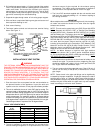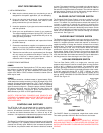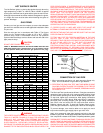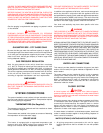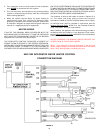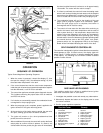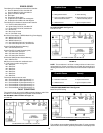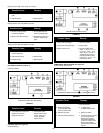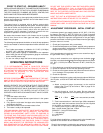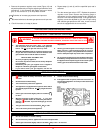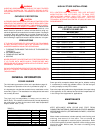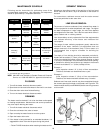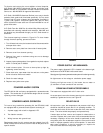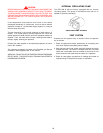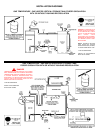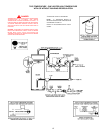
20
DO NOT USE THIS HEATER IF ANY PART HAS BEEN UNDER
WATER. IMMEDIATELY CALL A QUALIFIED SERVICE
TECHNICIAN TO INSPECT THE HEATER AND TO REPLACE ANY
PART OF THE CONTROL SYSTEM AND ANY GAS CONTROL
WHICH HAS BEEN UNDER WATER.
LIGHT THE UNIT IN ACCORDANCE WITH THE OPERATING
INSTRUCTIONS LABEL ATTACHED TO THE HEATER.
THESE INSTRUCTIONS ARE REPEATED IN THE LIGHTING AND
OPERATING LABEL ILLUSTRATION ON PAGE 20 IN THIS
MANUAL.
ADJUSTMENT PROCEDURE - INITIAL START-UP
A minimum dynamic gas supply pressure of 6.2" W.C. (1.54 kPa)
for Natural Gas and 11" W.C. (2.74 kPa) for LP Gas is required
before making any adjustment to the gas control pressure regulator
Attempts to adjust the regulator during periods of low gas supply
pressure could result in overfiring of the heater when the gas supply
pressure returns to normal.
1. Check gas line pressure with a manometer.
2. Check manifold pressure (see Table 4, page 20) using a pressure
gauge (manometer) connected to the manifold pressure tap on
the gas control valve, (Figure 15).
If full rate adjustment is required, remove cover screw from top of
the gas control valve, (Figure 15).
Using a small screwdriver, turn adjusting screw clockwise
to
increase or counterclockwise to decrease gas pressure to obtain
5.0" W.C. (1.25 kPa) for Natural Gas and 10" W.C. (2.49 kPa) for
LP gas.
3. Cycle the burner on and off several times to check its operation.
4. Check the operation of the limit and operating controls.
5. Check the vent system seams and joints and ensure that there
is no discharge of flue products into the room.
6. Check the input rate:
For appliance installation locations with elevations above 2000 feet
(610 m) refer to HIGH ALTITUDE INSTALLATIONS section of this
manual.
a. Attach a pressure gauge (manometer) to the manifold
pressure tap (Figure 16) and refer to Table 4, page 20 for
correct pressure.
b. Use this formula to “clock” the meter. Be sure other gas
consuming appliances are not operating during this interval.
3600
T
T = Time in seconds to burn 1 cubic foot of gas. (With a stopwatch
read the gas meter and measure the amount of time required
for the heater to consume 1 cubic foot of gas.)
H = Heating value of gas (in Btu’s per cubic foot of gas).
Btuh = Actual heater input rate, in Btuh.
EXAMPLE: (Using BTH-300 heater)
T = 12.6 seconds
H = 1050 Btu/ft.
3
BTUH = ?
For high altitude installations, compare result to the derated input
required for the elevation at the installation location.
Should it be necessary to adjust the gas pressure to the burner,
to obtain the full input rate, the steps below should be followed:
PRIOR TO START UP - REQUIRED ABILITY
INSTALLATION OR SERVICE OF THIS WATER HEATER REQUIRES
ABILITY EQUIVALENT TO THAT OF A LICENSED TRADESMAN IN
THE FIELD INVOLVED. PLUMBING, AIR SUPPLY, VENTING, GAS
SUPPLY AND ELECTRICAL WORK ARE REQUIRED.
Before attempting start-up, thoroughly study and familiarize yourself
with the exact sequence of operation and all other details on the
specific heater being used.
The power burner is equipped with an ignition system which
automatically sequences prepurge and ignition, senses and ignites
main burner flame and sequences burner operation. Heater is
equipped with an ignition control which locks out after three
unsuccessful ignition attempts. Familiarize yourself with the
sequence of operation of this unit prior to start-up.
Be certain that the water heater is full of water, that air is purged
from all lines, there are no leaks (gas and water), and all inlet
water lines are open.
The following test equipment should be on hand (all test equipment
must be acclimated to ambient temperature before calibration and
use.)
– Two U-tube manometers or calibration 0-10" W.C. (0-2.5Kpa)
and 0-35" W.C. (0-8.7Kpa) pressure gauges.
• Attach a gas pressure gauge or manometer to the upstream
side of main gas cock and a gas pressure gauge or manometer
to the manifold pressure tap.
• You are now ready to begin the burner start-up procedure.
OPERATING INSTRUCTIONS
IMPORTANT
IT IS RECOMMENDED THAT A QUALIFIED SERVICE
TECHNICIAN PERFORM THE INITIAL FIRING OF THE HEATER.
AT THIS TIME THE USER SHOULD ASK THE TECHNICIAN ANY
QUESTIONS IN REGARD TO THE OPERATION AND
MAINTENANCE OF THE UNIT.
CAUTION
BEFORE PROCEEDING WITH THE OPERATION OF THE UNIT,
MAKE SURE HEATER AND SYSTEM ARE FILLED WITH WATER
AND ALL AIR IS EXPELLED FROM HEATER AND PIPING.
NEVER OPERATE THE HEATER WITHOUT FIRST BEING
CERTAIN IT IS FILLED WITH WATER AND A TEMPERATURE
AND A PRESSURE RELIEF VALVE IS INSTALLED IN THE RELIEF
VALVE OPENING OF THE HEATER. DO NOT ATTEMPT TO
OPERATE HEATER WITH COLD WATER INLET VALVE CLOSED.
FILLING:
1. Close the heater drain valve.
2. Open a nearby hot water faucet to permit the air in the system
to escape.
3. Fully open the cold water inlet pipe valve allowing the heater
and piping to be filled.
4. Close the hot water faucet as water starts to flow.
5. The heater is ready to be operated.
THE MAIN MANUAL GAS SHUTOFF VALVE MUST HAVE BEEN
CLOSED FOR AT LEAST FIVE (5) MINUTES. THIS WAITING
PERIOD IS AN IMPORTANT SAFETY STEP. ITS PURPOSE IS
TO PERMIT GAS THAT MIGHT HAVE ACCUMULATED IN THE
COMBUSTION CHAMBER TO CLEAR. IF YOU DETECT GAS AT
THE END OF THIS PERIOD, DO NOT PROCEED WITH
LIGHTING. RECOGNIZE THAT GAS ODOR, EVEN IF IT SEEMS
WEAK, MAY INDICATE THE PRESENCE OF ACCUMULATED
GAS SOMEPLACE IN THE AREA WITH A RISK OF FIRE OR
EXPLOSION. SEE THE FRONT PAGE FOR STEPS TO BE TAKEN.
X H = Btuh
3600
X 1050 = 300,000 Btuh (87.9 kW)
12.6



